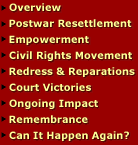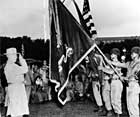




"You fought not only the enemy, but you fought prejudice – and you won. Keep up that fight, and we will continue to win – to make this great Republic stand for just what the Constitution says it stands for – the welfare of all the people, all the time."
– President Harry Truman, in presentation of the Presidential Distinguished Unit Citation to the 100 /442nd Regimental Combat Team, 7/15/46.
|
U.S. Army photo, National Archives, Courtesy of National Japanese American Historical Society
 
|
 |
 |

 |
|
The challenges and burdens of resettlement after the internment were shouldered primarily by members of the Nisei generation (second-generation, American-born Japanese Americans).
Most Nisei came of age during and after the internment years. Having witnessed the sacrifices and losses of their Issei (first-generation Japanese immigrant) parents, the Nisei persevered as active citizens, determined to claim their rightful place in America.
The vibrant pre-war Japanese American communities, including Little Tokyo in Los Angeles, Japantown in San Francisco, and many small farming communities on the West Coast were greatly diminished in the post-war period. Although many returned, a significant number of Japanese Americans resettled permanently in East Coast and Midwest states.
Those who returned to their pre-war homes often found them vandalized and even marred with racial epithets. Many farms and fields were in shambles from neglect or lost to new owners.
Through the 1950s, many Japanese Americans faced housing and employment discrimination and were denied access to many recreational and retail services. Many had to start over with their lives. They often had to share housing with friends or relatives, seek rooms in boarding homes or clustered together in trailer parks. Many had to become migrant workers, taking on any jobs they could find.
Despite losses in property, businesses, homes, and communities, most Japanese Americans, in time, rebuilt their lives. The Nisei raised their families, took care of their aging parents, and became active in schools and community activities.
 Empowerment Empowerment |
|
|
 |
|
|
|
|
|
 |
Site Overview • Help
World War II & Roundup • Camps Experience • Post War & Impact Today
Home • About the Project • For Educators • Other Resources
Day of Remembrance
Copyright 2002. National Asian American Telecommunications Association. All Rights Reserved.
|
|

